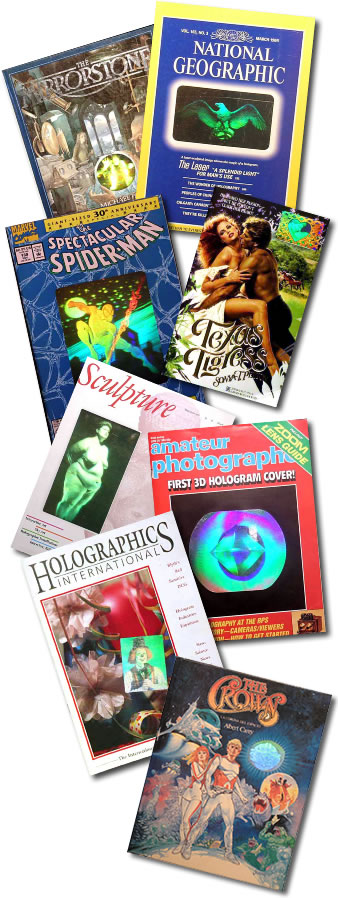 In June 1983, when Amateur Photographer published its ‘First 3D Hologram cover’ - a 4”x5” 2-colour image designed by Ken Harris - to coincide with the Light Dimensions exhibition at the Royal Photographic Society in Bath, a new era in illustration and a new opportunity for holography had begun. The following year, in March 1984, when The National Geographic Magazine used a 2.5” x 4” embossed hologram of the AmericanEagle on the cover of Vol.165, No.3 of its august journal with a print run of several million, the phenomenon went global.
In June 1983, when Amateur Photographer published its ‘First 3D Hologram cover’ - a 4”x5” 2-colour image designed by Ken Harris - to coincide with the Light Dimensions exhibition at the Royal Photographic Society in Bath, a new era in illustration and a new opportunity for holography had begun. The following year, in March 1984, when The National Geographic Magazine used a 2.5” x 4” embossed hologram of the AmericanEagle on the cover of Vol.165, No.3 of its august journal with a print run of several million, the phenomenon went global.
Prior to that, in 1967, Science Year had included a laser transmission hologram supplied by Conductron Corporation and in 1971 Les Prix Nobel had a reflection hologram by McDonnel Douglas Electronic Co. bound in to mark Dennis Gabor’s award, but both of these were pretty much one-offs of their kind. Embossed holograms on books and magazines, followed subsequently, to a lesser extent, by photopolymer holograms, became considerably more ubiquitous.
National Geographic’s special on The Laser and The Wonders of Holography was followed up in November 1985 with a 5”x4” 2-colour holographic image of a 2 million year old skull and in December 1988 by a full wraparound holographic cover to mark the beginning of their second century of publishing. Neither of these issues contained any feature on holography and the medium was simply being used for its illustrative abilities and, of course , to boost sales.
In the meantime there were some landmark publications: The Mirrorstone, published by Jonathan Cape in 1986, included a number of embossed holograms produced by Light Fantastic, hotfoil stamped onto conventional printed illustrations, to add another dimension to a children’s book by Michael Palin, Alan Lee and Richard Seymour. Also in 1986 Print Buyer magazine was the first to feature a holographic stereogram on the cover with an image of a smiling woman from Light Impressions. In 1985, Zebra Books in the USA began to use a small holographic logo on the front of their pulp fiction imprint to distinguish their product from the reams of competitors, with marked success. In November 1988, The RPS’s Photographic Journal applied a mass-replicated silver halide hologram by Applied Holographics to its member’s newsletter, but until the advent of photopolymer images in the early 1990s this style of holographic embellishment did not really catch on.
There were lots of firsts and probably even more things claiming to be, but until the comics book trade adopted holography it wasn’t getting regular usage in any particular section of the printing industry. It has to be said that Holography and comics were made for each other - the flashy silver foil and rainbow colours of holography meshed seamlessly with the action packed graphics and bold typography long associated with superheroes and their ilk, and comic book cover designers seemed to understand what to do with holography better than anyone in the straight magazine world. Rather than just plonking a square hologram onto an existing cover design they used foil to integrate with the artwork in a truly imaginative fashion.
In the childrens’ books field the designers at Orchard Books, Tango Books, Templar Publishing, and the other imprints that employed Light Fantastic (subsequently Opsec) to produce holograms for them, also did a very nice job of integrating holography with illustration in a more gentle, English style and a charming series of books resulted.
Science fiction and horror were also natural bedfellows for holography and quite a number of paperbacks appeared with 2-channel images of dinosaurs, aliens and ghouls to entice the book buying public.
In more esoteric realms, various holographic journals were the beneficiaries of holograms from a wide range of sources and Real Image, Holographics International, Wavefront, L.A.S.E.R. News and Optische Fenomenen, amongst others, purveyed the latest developments to their committed readerships.
Fashions in illustration come and go, however, and holography, more than most mediums it seems, is at the mercy of their vagaries. Recently there appears to be a fall in the use of holography in print (apart from the everpresent packaging and security uses) but since, to my mind at any rate, illustration uses holography in one of its most appropriate ways, I hope and expect it to return before long.
Jonathan Ross

